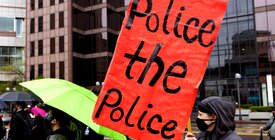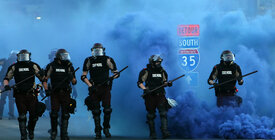Expanding the Role of Non–Law Enforcement First Responders
States and localities have long relied primarily or solely on law enforcement to resolve a host of social matters. In fact, 911 calls that are dispatched to law enforcement most frequently concern “disorder,” a broad term that may refer to noise complaints, trespassing, public intoxication, loitering, disturbing the peace, public urination, or vagrancy. By one account, at least one in 10 calls for service involves someone who is experiencing a mental health crisis or diminished mental capacity. Law enforcement officers are frequently the only source of immediate service to people in urgent need, often putting people with behavioral health problems on a path to incarceration rather than treatment. In fact, the largest institutions providing mental health care in the United States are the jail systems in New York, Los Angeles, and Chicago.
But incarceration is not the only consequence of this dependence on law enforcement. Police responses to incidents involving mental health or substance use can quickly escalate into violence and result in serious physical injury or death to the person in crisis as well as bystanders and responding officers. Several high-profile instances of police use of deadly force — such as the 2021 killing of Walter Wallace Jr. in Philadelphia — highlight the consequences of tasking armed police, who often lack medical expertise, with responding to these fraught situations. Indeed, people with untreated mental illness are 16 times more likely to be killed by law enforcement than other members of the public. Such risks are even higher for people from marginalized groups. A 2018 study found that Black men with mental illness were more likely to be killed by police than people from any other racial or ethnic group, with or without a behavioral health disorder.
For these reasons, many law enforcement personnel have argued that they are ill suited to deal with the myriad social problems to which they currently respond. As early as the 1990s, local governments and law enforcement agencies began looking for ways to mitigate risks by implementing innovative co-responder models, which pair officers with unarmed community responders — often licensed clinicians or specialists such as paramedics, therapists, or social workers with expertise in fields such as behavioral health, homelessness, or domestic violence. Less common but growing in number are alternative first responder models, which remove law enforcement officers from the first response altogether. They include mobile crisis teams (MCTs) — such as the long-standing Crisis Assistance Helping Out on the Streets (CAHOOTS) program in Eugene, Oregon — that dispatch specialists in response to calls for service involving nonviolent activities with a behavioral health component. These teams not only provide immediate assistance but also can follow up to address underlying issues having to do with medical or behavioral health, housing, or even family or neighborhood disputes. Another type of alternative first responder handles calls for service that originate with complaints about poverty-related activities, such as panhandling or trash picking. Law enforcement officers are called in only if a situation escalates or poses a greater risk of violence than originally described.
Both co-responder and alternative first responder programs, particularly MCTs, have a proven record of reducing unnecessary arrests and emergency hospitalizations while connecting people to appropriate community-based services and treatment. These programs can also help free up law enforcement and health-care resources for other urgent purposes. In Tulsa, for instance, the adoption of a co-responder model freed more than 800 other first responder units to deal with higher-priority calls during the program’s first year of operation. Programs can also produce long-term cost savings, as was the case in Eugene, where the deployment of CAHOOTS teams saved the city an estimated $14 million in emergency medical services in 2019. These benefits, coupled with public demand, have led to a notable uptick in the adoption of both models across the country, with 62 percent of the top 50 jurisdictions creating at least one such program since 2020.
Co-responder Programs
Between January 2020 and July 2022, at least 15 jurisdictions out of the top 50 created new co-responder programs. While this analysis focuses on new programs, law enforcement agencies across the country have been taking this approach for decades. At least 28 of the top 50 already had at least one co-responder program in place prior to 2020.
Most of the newest programs focus on behavioral health calls involving mental health crises or substance use. Some, such as Detroit’s Homeless Outreach Team, are tailored to respond to complaints involving unhoused people.
At least eight of the new co-responder programs were launched as pilots, established with a limited number of units and in some cases targeting select neighborhoods for a specified period. Philadelphia’s pilot program, for example, consists of just four teams operating on a single shift to serve a city of 1.6 million people. Tampa’s one-year pilot was also leanly staffed, with just four officers and four mental health professionals for a city of 380,000 people. Localities with successful pilots have subsequently scaled up their programs’ staffing, resources, geographical scope, and hours of service — as has been the case in Chicago, Detroit, Jacksonville, and Nashville. On October 6, 2022, Tampa City Council voted to extend the pilot for an additional two years.
Well-established programs such as the Crisis Intervention Response Team (CIRT) in Houston also started small. From its inception in 2008 as a pilot to address mental health crises, CIRT has grown to 12 full-time units providing citywide coverage. It plans to add units to provide 24-hour service. (Houston is also home to co-responder programs specializing in homelessness and domestic violence.)
Alternative First Responder Programs
At least 19 jurisdictions out of the top 50 have adopted first responder models since 2020 that offer alternatives to the deployment of law enforcement. Additional top 50 cities, including Boston, Jersey City, Miami, and Nashville, are exploring the development of similar programs.
Like many of the co-responder programs, these new alternative first responder programs often focus on behavioral health and homelessness, dispatching specialists to handle crises or calls that do not pose a public safety threat but require expertise.
Some jurisdictions, conscious that callers may be uncomfortable dialing 911, have repurposed their nonemergency 311 lines to handle calls for service. In Atlanta, calls regarding quality-of-life issues or concerns relating to mental health or substance use may result in the dispatch of a Harm Reduction Team of social service professionals. Similarly, Minneapolis expanded its 311 line to dispatch nonpolice city staff for nonviolent calls relating to theft, property damage, and parking complaints. While not included above, some cities among the top 50 — such as Long Beach, California, and Fort Worth, Texas — have created civilian positions within police departments to perform duties such as taking property crime reports or responding to complaints of abandoned cars.
The city of Albuquerque — where, in 2010, people with mental illness were three times more likely to be incarcerated than hospitalized — adopted a comprehensive strategy in 2021. The Albuquerque Community Safety Department (ACSD) resolves all nonviolent, nonmedical 911 calls for service. Its varied approach employs licensed mental health professionals who respond alongside law enforcement; pairs of behavioral health professionals who respond without law enforcement; and community responders who are trained to address low-priority issues such as inebriation, abandoned vehicles, accidents with no injuries, and needle pickups.
Most cities, however, have opted for less extensive programs that are limited to specified types of calls in targeted neighborhoods. For example, New York City’s new MCT, the Behavioral Health Emergency Assistance Response Division (B-HEARD), responds to behavioral health crises during designated hours in parts of Upper Manhattan and the Bronx. During the program’s first six months, 911 operators routed 22 percent of mental health–related calls in the initial pilot area to B-HEARD. In 2020, Denver’s new MCT pilot, Support Team Assisted Response (STAR), responded to just 13 percent of approximately 15,000 STAR-appropriate emergency calls.
In the coming years, however, these programs will likely expand. For example, after an early evaluation of STAR showed that it resolved its first 2,700 calls without injuries or arrests, Denver made significant investments to enable citywide coverage. Portland, Oregon, expanded its MCT, Portland Street Response (PSR), to provide citywide coverage in March 2022. San Francisco’s Street Crisis Response Team (SCRT) has also expanded significantly since its founding in 2020. In its first year, SCRT responded to more than 5,000 calls related to substance use and mental health, with 59 percent of encounters resolved at the scene (allowing clients to stay in their community), 14 percent of clients receiving non-ambulatory transport (often to urgent care clinics or shelters), and 15 percent receiving ambulatory transport. SCRT diverted 58 percent of mental health calls that would have previously gone to law enforcement, requesting police backup for only 3 percent of encounters. (There have been no reported instances of violence.) The program has now grown to seven teams of paramedics, clinicians, and trained community members who have themselves dealt with mental health or substance use challenges. The teams are operative all day and night, citywide.





